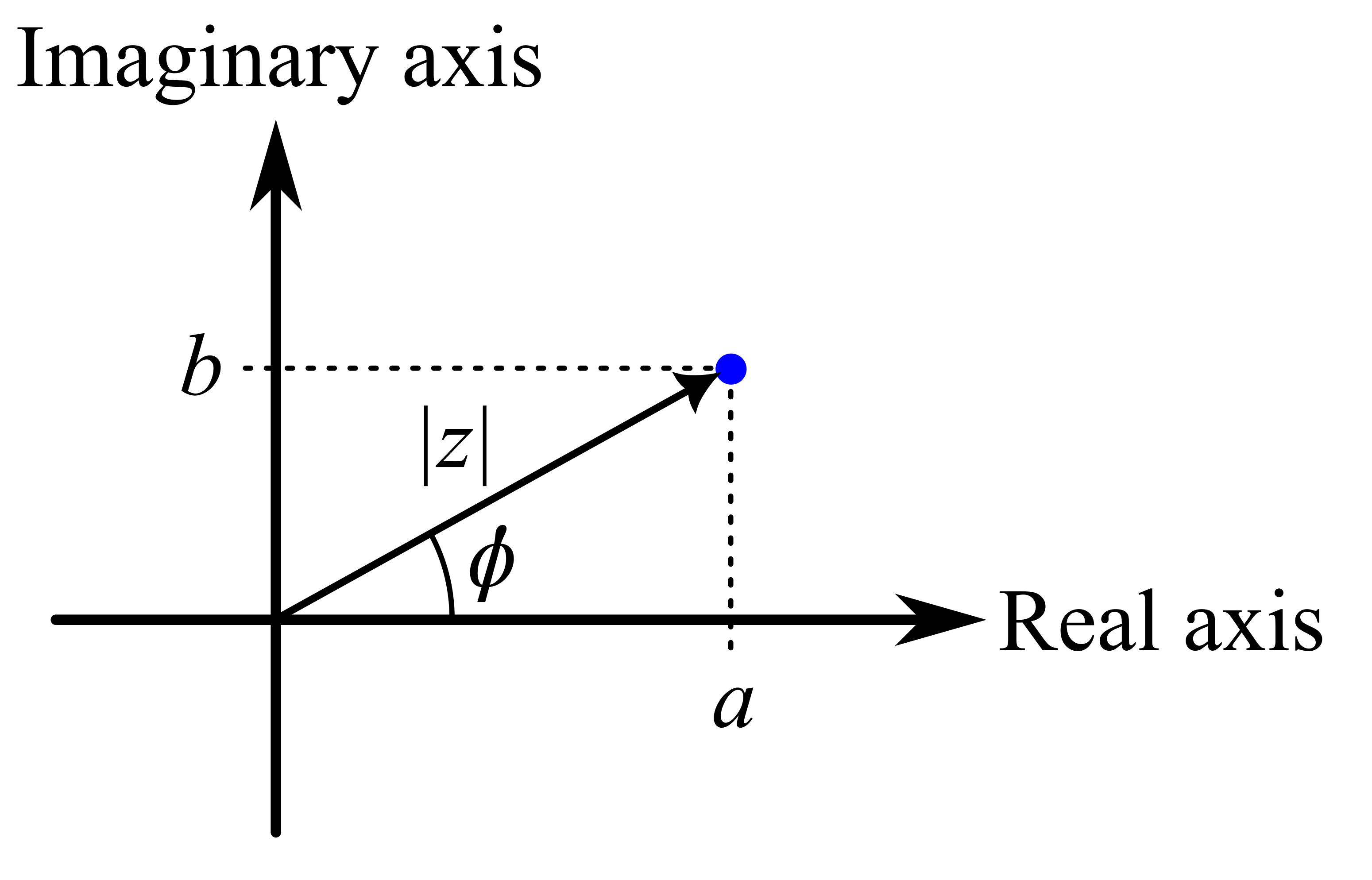A Review of Complex Numbers
Contents
1 Introduction
1.1 The Imaginary Number
The imaginary unit is \(\sqrt{-1}\). It is often referred to as \(i\), but in electronics, often \(I\) is used for a DC current (time independent) and \(i\) is used for an AC current (time dependent)… also sometimes this convention is flipped. For sake of clarity, even if \(i\) is not being used to represent current, \(j\) is often used in the context of electronics for representing the imaginary unit
\[j=\sqrt{-1}\]
1.2 A Complex Number
Complex numbers, generically are represented with the variable \(z\). In general, complex numbers have real and imaginary parts
\[z=a+jb\]
where \(a\) is the real part and \(b\) is the imaginary part
\[\text{Re}{[z]} = a\] \[\text{Im}{[z]} = b\]
It is easy to add and subtract complex numbers in this form
\[z_1 + z_2 = (a_1 + a_2) + j (b_1 + b_2)\]
Multiplying and dividing in this form is a bit trickier
\[z_1\cdot z_2 = (a_1a_2-b_1b_2) + j(a_1b_2+a_2b_1)\]
\[\frac{z_1}{z_2} = \text{no thanks}\]
1.3 The complex plane

Another common representation of complex numbers is to write them in terms of their amplitude and phase
\[z=|z|e^{j\phi}\]
where
\[|z| = \sqrt{a^2+b^2}\]
\[\tan\phi = \frac{b}{a}\]
This representation is better for multiplication and division
\[z_1\cdot z_2 = |z_1|\cdot|z_2|\ e^{j(\phi_1 + \phi_2)}\]
\[\frac{z_1}{z_2} = \frac{|z_1|}{|z_2|}\ e^{j(\phi_1 - \phi_2)}\]
2 Complex Conjugates
A complex conjugate \(z^*\) can be determined by replacing all instances of \(j\) with \(-j\).
If
\[z = a+jb = |z|e^{j\phi}\]
then
\[z^* = a - jb = |z|e^{-j\phi}\]
The magnitude of a complex number \(|z|\) can be calculated by taking the square root of the product of the complex number with its complex conjugate
\[|z| = \sqrt{zz^*}\]
3 Sinusoidal functions
3.1 Taylor expansions of sin, cos, and exp
\[\begin{split} e^{x} &= \sum_{i=0}^\infty \frac{x^i}{i!} = 1 + x + \frac{x^2}{2} + \frac{x^3}{6} + \frac{x^4}{24} + \frac{x^5}{120} + \frac{x^6}{720} + ...\\ \sin{x} &= \sum_{i=0}^\infty \frac{x^{2i+1}}{(2i+1)!} = x + \frac{x^3}{6} + \frac{x^5}{120} + ...\\ \cos{x} &= \sum_{i=0}^\infty \frac{x^{2i}}{(2i)!} = 1 + \frac{x^2}{2} + \frac{x^4}{24} + \frac{x^6}{720} + ... \end{split}\]3.2 Complex Exponential
\[\begin{split} e^{jx} &= \sum_{i=0}^\infty \frac{(jx)^i}{i!} = 1 + jx - \frac{x^2}{2} - j\frac{x^3}{6} + \frac{x^4}{24} + j\frac{x^5}{120} - \frac{x^6}{720} + ...\\ &= \bigg(1 + \frac{x^2}{2} + \frac{x^4}{24} + \frac{x^6}{720} + ...\bigg)+j\bigg(x + \frac{x^3}{6} + \frac{x^5}{120} + ...\bigg)\\ &= \cos{x} +j\sin{x} \end{split}\]This is the best form for keeping track of the phase of a wave.
3.2.1 Complex Transfer Functions
A transfer function is a time-independent relationship between an input and an output. It can be defined as
\[T = \frac{\text{output function}}{\text{input function}}\]
In this course, we will mostly use transfer functions to relate output voltages to input voltages, such that
\[V_\text{out}(t) = TV_\text{in}(t)\]
A transfer function can be complex. This means that applying it will not only scale the magnitude, but also shift the phase. A generic complex \(T\) is best put into the form
\[T = |T|e^{j\delta}\]
so that
\[V_\text{out}(t) = |T|V_\text{in}(t)e^{j\delta}\]
All waves can be represented in terms of sine or cosine wave components in a Fourier series.
\[\begin{split}V_\text{in}(t) =& \sum_i a_i \cos{(\omega_i t + \phi_i)}\\ V_\text{out}(t) =&\ T\sum_i a_i \cos{(\omega_i t + \phi_i)}\\ =&\ \sum_i a_i |T| \cos{(\omega_i t + \phi_i)}e^{j\delta} \end{split}\]
However \(\cos(\omega_i t+\phi_i)e^{j\delta}\) is not the easiest to work with. Instead, you can represent all cosines and sines as the real and imaginary parts of a single complex exponential
\[\cos{(\omega t + \phi)} \rightarrow e^{j(\omega t + \phi)}\]
This will make the math much easier to work with and then at the end, you can just take the real part. The equations above become
\[\begin{split}\tilde{V}_\text{in}(t) =& \sum_i a_i e^{j(\omega_i t + \phi_i)}\\ \tilde{V}_\text{out}(t) =& \sum_i a_i |T| e^{j(\omega_i t + \phi_i)}e^{j\delta}\\ =& \sum_i a_i |T| e^{j(\omega_i t + \phi_i+\delta)} \end{split}\]
And then the real part can be taken to find \(V_\text{out}\)
\[\begin{split} V_\text{out}&=\text{Re}[\tilde{V}_\text{out}]\\ &= \sum_i a_i |T| \cos{(\omega_i t + \phi_i+\delta)} \end{split}\]
So each cosine component gets scaled by \(|T|\) and shifted by an amount of time of \(\delta/\omega_i\) (aka a phase shift).
4 More identities
\[\begin{split} \cos{x} &= \frac{e^{jx}+e^{jx}}{2}\\ \sin{x} &= \frac{e^{jx}-e^{-jx}}{2j}\\ \cosh{x} &= \frac{e^x+e^{-x}}{2}\\ \sinh{x} &= \frac{e^x-e^{-x}}{2}\\ \cos{x} &= \cosh{jx}\\ \sin{x} &= j\sinh{jx}\\ e^{j 2\pi n} &= 1;\ \ \ \ \ \ \text{where } n\text{ is an integer}\\ e^{j (\pi + 2\pi n)} &= -1;\ \ \ \text{where } n\text{ is an integer}\\ e^{j (\frac{\pi}{2} + 2\pi n)} &= j;\ \ \ \ \ \ \text{where } n\text{ is an integer}\\ e^{j (\frac{3\pi}{2} + 2\pi n)} &= -j;\ \ \ \text{where } n\text{ is an integer} \end{split}\]5 Practice Problems
Write the following complex numbers in terms of magnitude and phase
\[z=\frac{A}{1+jx}\]
\[z=\frac{jx}{1+jx}\]
Let \(z_1=\sqrt{8}e^{j\frac{3\pi}{4}}\), \(z_2=2e^{j\frac{\pi}{6}}\)
Represent \(z_1\) and \(z_2\) in the complex plane and find their real and imaginary parts
Evaluate \(z_1 + z_2\) and \(z_1^2z_2^3\)
By writing out \(\cos\theta\) in terms of exponentials and using the binomial expansion, express \((\cos\theta)^5\) in terms of \(\cos\theta\), \(\cos 3\theta\), and \(\cos 5\theta\).
Evaluate the sum
\[\sum_{n=-N}^N\cos(\theta+n\phi)\]
- Suppose that frequencies \(\omega_1\) and \(\omega_2\) differ only slightly. Using the complex exponential, express the sum
\[A_0\cos\omega_1 t +A_0\cos\omega_2 t\]
(where \(A_0\) is a constant) in the form of
\[A(t)\cos\frac{\omega_1+\omega_2}{2}t\]
where \(A(t)\) is a slowly varying function of time.